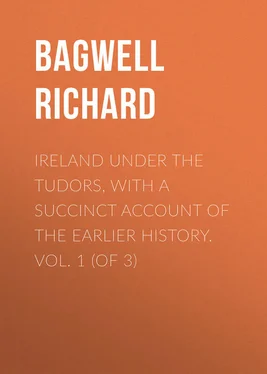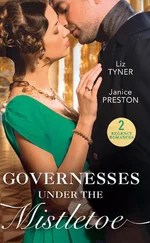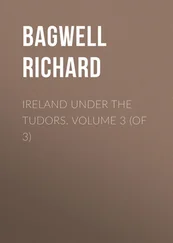Richard Bagwell - Ireland under the Tudors, with a Succinct Account of the Earlier History. Vol. 1 (of 3)
Здесь есть возможность читать онлайн «Richard Bagwell - Ireland under the Tudors, with a Succinct Account of the Earlier History. Vol. 1 (of 3)» — ознакомительный отрывок электронной книги совершенно бесплатно, а после прочтения отрывка купить полную версию. В некоторых случаях можно слушать аудио, скачать через торрент в формате fb2 и присутствует краткое содержание. Жанр: foreign_antique, foreign_prose, Историческая проза, на английском языке. Описание произведения, (предисловие) а так же отзывы посетителей доступны на портале библиотеки ЛибКат.
- Название:Ireland under the Tudors, with a Succinct Account of the Earlier History. Vol. 1 (of 3)
- Автор:
- Жанр:
- Год:неизвестен
- ISBN:нет данных
- Рейтинг книги:4 / 5. Голосов: 1
-
Избранное:Добавить в избранное
- Отзывы:
-
Ваша оценка:
- 80
- 1
- 2
- 3
- 4
- 5
Ireland under the Tudors, with a Succinct Account of the Earlier History. Vol. 1 (of 3): краткое содержание, описание и аннотация
Предлагаем к чтению аннотацию, описание, краткое содержание или предисловие (зависит от того, что написал сам автор книги «Ireland under the Tudors, with a Succinct Account of the Earlier History. Vol. 1 (of 3)»). Если вы не нашли необходимую информацию о книге — напишите в комментариях, мы постараемся отыскать её.
Ireland under the Tudors, with a Succinct Account of the Earlier History. Vol. 1 (of 3) — читать онлайн ознакомительный отрывок
Ниже представлен текст книги, разбитый по страницам. Система сохранения места последней прочитанной страницы, позволяет с удобством читать онлайн бесплатно книгу «Ireland under the Tudors, with a Succinct Account of the Earlier History. Vol. 1 (of 3)», без необходимости каждый раз заново искать на чём Вы остановились. Поставьте закладку, и сможете в любой момент перейти на страницу, на которой закончили чтение.
Интервал:
Закладка:
The early history of the native Irish Church is shrouded in much obscurity. The best authorities are disposed to accept St. Patrick as the apostle of Ireland, the fifth century as the period of his labours, and Armagh as his chief seat. He was not a native of Ireland; so much seems certain. A more interesting, because a more clearly defined figure, is that of Columba or Columkille, who was born in Donegal in 521. The churches of Derry, Durrow, Kells, Swords, Raphoe, Tory Island, and Drumcliff, claim him as their founder; but it is as the apostle of North Britain that he is best known. He was religious from his youth, but a peculiarly serious tinge was given to his mind by a feeling of remorse for bloodshed which he had partly caused. He had surreptitiously transcribed a psalter belonging to another saint, who complained of this primitive infringement of copyright. A royal decision that ‘to every cow belongs her calf’ was given, and was followed by an appeal to arms. Exile was then imposed as a penance on Columba, whose act had been the original cause of offence. Such was long the received legend, but perhaps the exile was voluntary. 12Whether his departure was a penance or the result of a vow, tradition says that he was bound never to see Ireland again, that he landed first on Oronsay, but found that Erin was visible from thence, and refused to rest until he had reached Iona. His supposed feelings are recorded in a very ancient poem: —
‘My vision o’er the brine I stretch
From the ample oaken planks;
Large is the tear of my soft grey eye
When I look back upon Erin.
Upon Erin my attention is fixed.’
Columba was the Paul of Celtic Christianity. By him and his disciples a great part of Scotland was evangelised, and it was to him that the British Church looked as a founder when the time came to decide between the relative pretensions of the Celtic and the Norman type of religion. St. Bridget or Bride, who died four years after Columba’s birth, is scarcely less celebrated. She was born near Dundalk, and her chief seat was at Kildare. She was the mother of Irish female monachism, and in popular estimation is not less famous than Patrick, and perhaps more so than Columba. 13
Irish Christianity was at first monastic. A saint obtained a grant of land from a chief. A church was built, and a settlement sprung up round it. The family, as it was called, consisted partly of monks and partly of dependents, and the abbot ruled over all as chief of a pseudo-tribe. Like a lay chiefry the abbacy was elective, and the abbots wielded considerable power. These ecclesiastical clans even made war with each other. Thus, it is recorded that in 763 the family of St. Ciaran of Clonmacnoise fought with the family of St. Columba of Durrow, and that 200 of the Columbides fell. The head of such a confraternity was called coarb, or successor of the founder, and Irish writers sometimes called the Pope ‘coarb of Peter.’ In course of time the coarb of Patrick crystallised into the Archbishop of Armagh, and the coarb of Columba into the Bishop of Derry. Other saints were revered as the founders of other sees. Very often at least the abbot was chosen from among the founder’s kin.
Episcopal orders were acknowledged from the first, but it was long before the notion of a territorial bishop prevailed. In early days there were many bishops, wanderers sometimes, and at other times retained by the abbot as a necessary appendage to his monastery. The bishop was treated with great respect, but was manifestly inferior to the head of a religious house. St. Patrick was said to have consecrated 350 bishops, founded 700 churches, and ordained 5,000 priests; a mere legend, but perhaps tending to show that the episcopal order was very numerous in Ireland. Travelling bishops without definite duties, and with orders of doubtful validity, became a scandal to more regularly organised churches, and drew down a rebuke from Anselm as late as the beginning of the twelfth century. At an earlier period impostors pretending to be Irish bishops were not uncommon. 14
The Irish Church long continued to keep Easter on a different day from that sanctioned by Rome, and to use a different form of tonsure. But the inconvenience of such dissidence from the general body of Western Christendom was soon felt. About 630 Pope Honorius I. addressed a letter to the Irish Church, in which he reminded the clergy that they were a scanty company inhabiting a remote region, and that it could not be for their interest to remain isolated. Cummian, afterwards seventh abbot of Iona, warmly espoused the papal cause. ‘Rome errs,’ he said with great scorn, ‘Jerusalem errs, Alexandria errs, Antioch errs, the whole world errs – the Britons and Irish are the only right-minded people.’ The southern Irish followed Cummian, but the northern rejected his advice, and some even called him a heretic; yet this did not prevent his being elected to fill Columba’s chair. Adamnan, ninth abbot of Iona, and biographer of the great founder, was no less earnest on the Roman side than Cummian had been. At the Synod of Whitby in 664 Wilfred discomfited Colman of Lindisfarne, and settled the question so far as England was concerned. Adamnan lived till 704, and succeeded in converting nearly all the Irish churches, except those subject to his own monastery.
In 716, under Duncadh, the eleventh abbot, Iona conformed, and the Paschal controversy came to an end, after lasting 150 years. The coronal tonsure was adopted three years later. The supremacy of Rome was thus acknowledged, but circumstances long prevented the Irish from adopting the Roman plan of Church organisation.
The Scandinavian inroads began towards the close of the century which witnessed the submission of Iona. It is probable that the influx of pagan Northmen kept Ireland apart from the rest of Christendom. The ninth century produced Erigena and other eminent Irishmen, but a country in which Christianity was fighting for bare life was not a promising field for Church reformers or systematisers. It was not until Clontarf had finally decided the cause in favour of Christianity that Ireland had again leisure to think of ecclesiastical polity. Gillebert of Limerick, an Ostman, was the first papal legate, and as such presided at the synod of Rathbreasil in or about 1118, where the first serious attempt was made to divide all Ireland into dioceses. The great influence of Malachi of Armagh was exerted in the same direction. He was the friend of Bernard of Clairvaux, and he introduced the Cistercian order into Ireland. Pope Eugenius III., himself a Cistercian, finished the work, and in 1151 Ireland accepted four archiepiscopal palls from Rome. From that date the Irish Church must be held to have fully accepted not only papal supremacy but Roman organisation. That she had not done so long before seems due to accident more than anything else. From mere remoteness of position Ireland had escaped the dominion of Imperial Rome. From the same remoteness she was comparatively slow to feel the influence of Papal Rome. Still, it can scarcely be doubted that had it not been for the Scandinavian intrusion, the Ireland which adopted the Roman Easter and the Roman tonsure before the middle of the eighth century, would have gladly accepted the palls long before the middle of the twelfth. 15
Читать дальшеИнтервал:
Закладка:
Похожие книги на «Ireland under the Tudors, with a Succinct Account of the Earlier History. Vol. 1 (of 3)»
Представляем Вашему вниманию похожие книги на «Ireland under the Tudors, with a Succinct Account of the Earlier History. Vol. 1 (of 3)» списком для выбора. Мы отобрали схожую по названию и смыслу литературу в надежде предоставить читателям больше вариантов отыскать новые, интересные, ещё непрочитанные произведения.
Обсуждение, отзывы о книге «Ireland under the Tudors, with a Succinct Account of the Earlier History. Vol. 1 (of 3)» и просто собственные мнения читателей. Оставьте ваши комментарии, напишите, что Вы думаете о произведении, его смысле или главных героях. Укажите что конкретно понравилось, а что нет, и почему Вы так считаете.












